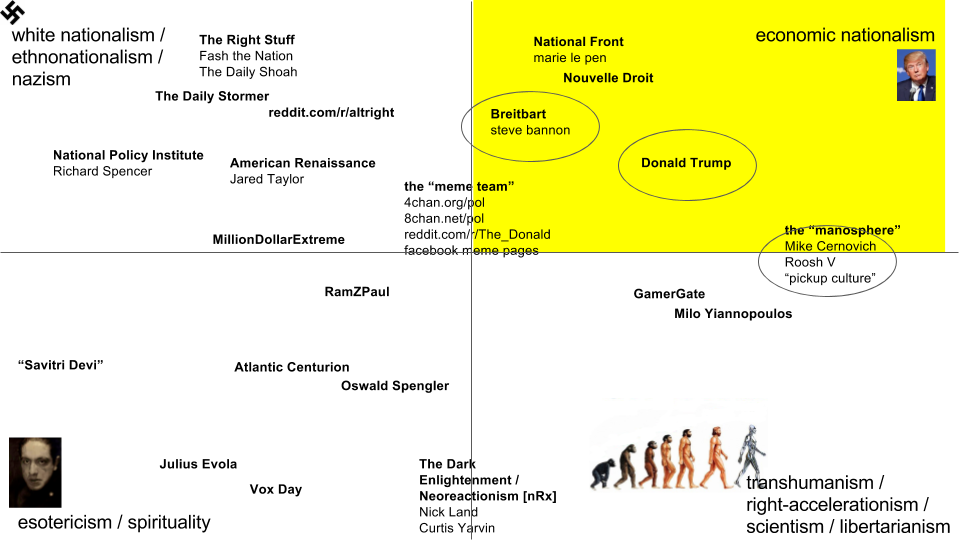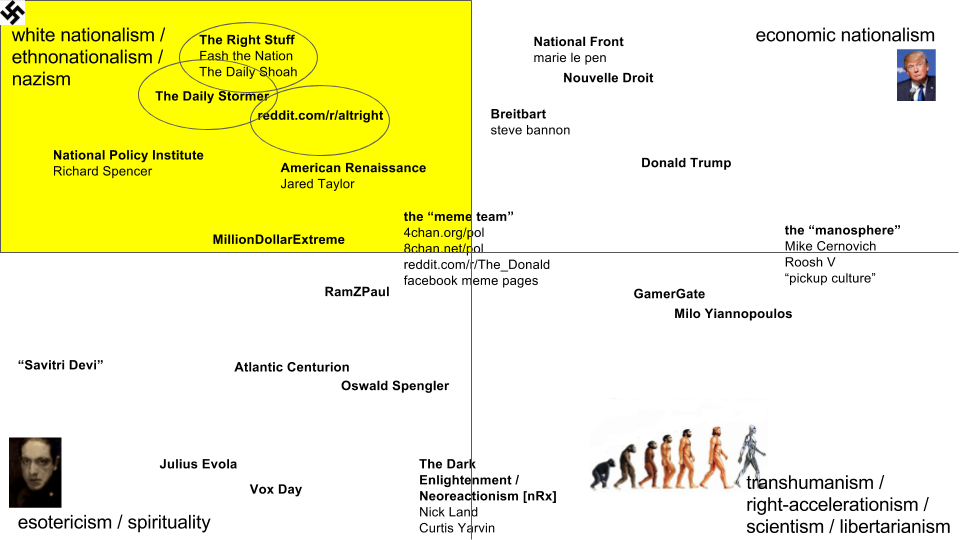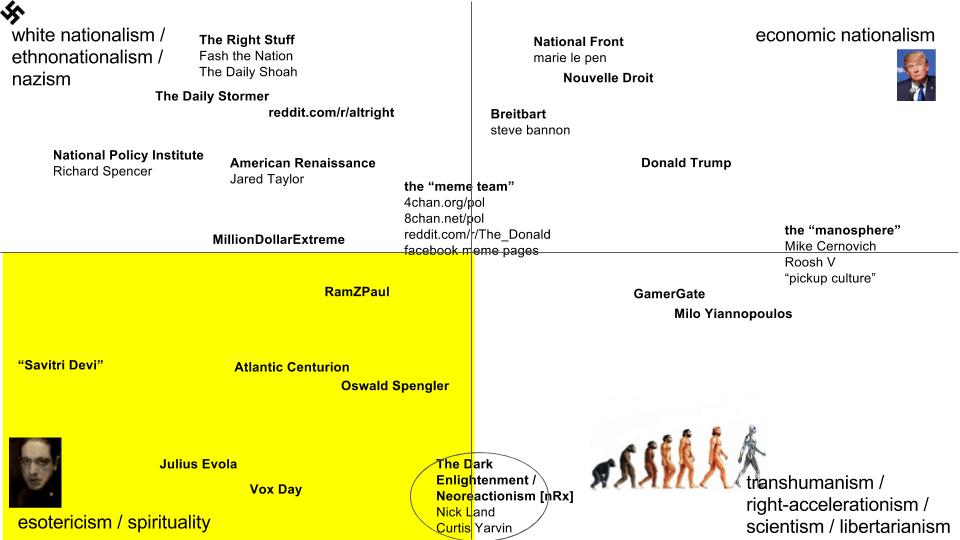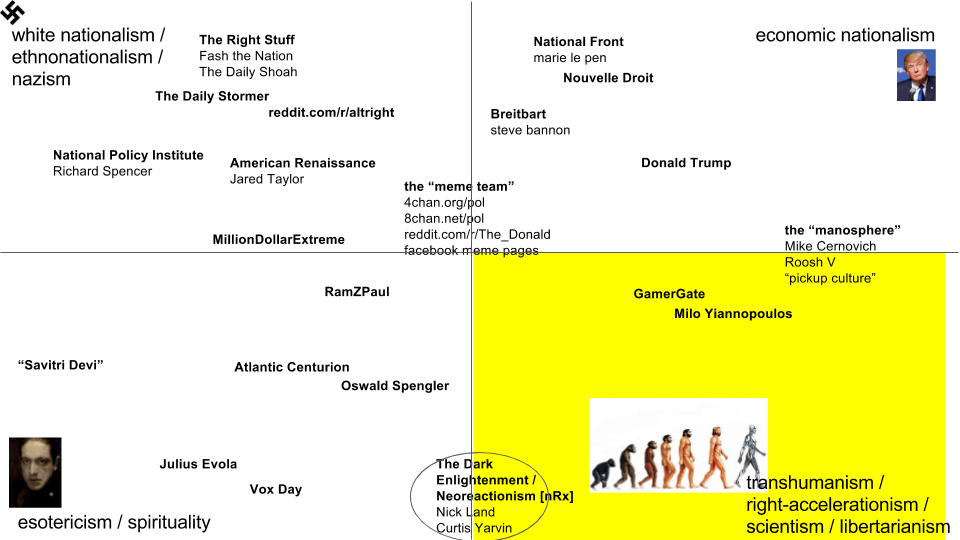
Editor’s Note: This article includes an in-depth inquiry into the online activities of political groups for which misogyny, racism, and anti-semitism become defining features; as such, images and mentions of those topics are found in the text.
Estimated read time: 29 minutes.
For the greater part of the past year, I’ve been surveying the aesthetic sensibilities of nationalist internet hubs such as Breitbart, /pol, r/the_donald, and similarly affiliated Facebook pages. These communities constitute what journalists and theorists have come to refer to as the alt-right—online neo-fascist groups whose growth mirrors and informs the growing nationalist, nativist sentiment as it is represented in the recent electoral success of the UK Independence Party, the Trump campaign, Austria’s Freedom Party, the French National Front, and Germany’s Alternative for Deutschland Party.
Briefly, before I begin thematizing the aesthetics of the alt-right, it is necessary to outline the definition of fascism that I am using in this essay. Fascism is an amorphous term with a multitude of definitions; the task of defining fascism has been attempted by numerous theorists including Deleuze and Guattari, Walter Benjamin, Arthur Rosenburg, Wilhelm Reich, and more. One useful definition I have encountered comes from semiotician Umberto Eco, who himself was a child during Mussolini’s fascist regime. In his essay Ur-Fascism, Eco identifies themes and rhetorical habits that underpin fascism (although his interrogation is limited to describing what fascism looks and sounds like, as opposed to the mechanism by which it emerges).1 Some of the characteristics that I will refer to in my aesthetic survey include:
- the cult of tradition which idealizes a primordial past (think Make America Great Again, or Mussolini’s call to build a new Rome, a call recently echoed by White Nationalist Richard Spencer2).
- fear of difference, whether difference be sexual, gendered, religious, or racial.
- a cult of masculinity that, tends to manifest itself in an obsession with sexual politics (refer to online pick-up artistry and the heteronormative gender roles embodied in the nuclear family.)
- a hostility towards parliamentary politics, criticality, and reason.
- a belief in permanent warfare and a corresponding cult of action for action’s sake.
- a worship of technology, not in the manner of an Enlightenment-esque worship of reason, but faith in technology to conquer and to reaffirm inegalitarianism.
The online neo-fascist movement, the alt-right consists of a number of different groups, although certain tenets (all of which align with Eco’s criteria for ur-Fascism) are quite consistent throughout these communities in some form or fashion—a preference for authoritarianism over democracy, scientific racism and misogyny under the palatable term “human biodiversity,” and suspicion towards what they perceive to be the cultural hegemony of the left as evidenced in the liberal leanings of the mainstream media, the entertainment industry, and academia. Their economic views are difficult to discern, with protectionism, accelerated free market global capitalism, and anarcho-capitalism all being advocated in different communities.
 (fig. a)3
(fig. a)3
Indexing these movements across a two axis chart (fig. a) is productive for the intents and purposes of this paper; however, what is most interesting to observe is instances in which these communities convene in internet “public spaces” (which are not public at all), most notably reddit and 4chan. Their creative propagandic images are disseminated throughout social media and oftentimes matriculate all the way up to the Twitter accounts of political leaders, activists, entertainers, and of course, into our national consciousness. As I will refer to this chart throughout this essay, I would like to clarify its organizational logic. Groups, terms, and individuals are plotted according to their variations on the central tenets of the alt-right’s ideological disposition, namely in regards to Nationalism and Faith.
Nationalism in general is a defining characteristic of the alt-right; however, within the nationalist ideology there are degrees of variation, particularly in regard to the status of Jewish people and Israel. Representatives from groups that more closely embody economic nationalism can still be considered mainstream figures since their rhetoric skirts around social issues such as race and religion. On the opposite side, the groups share a nationalist ideology, but the rhetoric takes on a distinctly racialized, often anti-Semitic, tone—a stark contrast to the staunchly pro-Israel economic nationalist groups epitomized in the Trump Administration itself.
Towards the bottom of the chart, the religio-philosophical underpinnings of the alt-right contrast. On the left side of the chart are the individuals and movements that place their faith in inegalitarian readings of traditionally recognized religion. Perhaps echoing Julius Evola’s spiritual racism, various communities re-read Christian mysticism, Zen Buddhism, and Hindu polytheism, ultimately and bewilderingly drawing White Supremacist conclusions. On the bottom-right, we see a more technocratic, hypercapitalist neo-fascism that places its faith in markets, accelerated capitalism, and “empirical” science to reveal the truly inegalitarian hierarchy key of racial classification. In a sense, there is a loose historical allegory to be found here: the spiritual quadrant of the alt-right finds coherence in Julius Evola’s spiritual justification for fascism (a concept that was quite appealing to Mussolini), while the techno-determinist quadrant draws influence from Nazist racism, which uses a biological justification. Thus, opposite axes should not be understood as antithetical; the axes are constitutive and relational, accounting for variations in nationalism and faith.
* * *
The faction of the alt-right that I’ve labeled as “economic nationalist” (fig. b) is the most recognizable aspect of the alt-right; it can be argued that they now occupy the executive branch of the United States government. At the very least, they (via the appointment of Breitbart News executive chair Steve Bannon as Trump’s new strategist) occupy the position of the President-Elect’s right-hand man. Beyond Bannon and Trump, self-identified major contributors of the public alt-right include Breitbart, its tech editor Milo Yiannopolous, and international populist movements such as the National Front. These movements, figures, and publications have found a receptive audience in a number of online communities that are defined by gamer culture and what has been in the past referred to as the Manosphere. Almost exactly as it sounds, the Manosphere refers to a loose affiliation of anti-feminist men’s rights groups across the internet, including the subreddits r/theredpill, r/mgtow4 and forums such as bodybuilding.com and a variety of smaller blogs.5 The Manosphere also focuses on pickup artistry (PUA) or seduction training, which attempts to pathologize female personality types and empirically develop strategies to seduce them. One popular figure in the Manosphere is social media personality Mike Cernovich, who was recently profiled in a New Yorker article entitled Trolls for Trump.6 Cernovich is the author of The Gorilla Mentality, which epitomizes the interests of “the mansophere,” including gender essentialism, pickup artistry, “alpha-male” culture, rape apologetics, anti-feminism, and being redpilled7.
 (fig. c)
(fig. c)
This image (fig. c) is pulled from the Facebook meme page Edgy Memes and Fashy Dreams. In it, we see a number of racist and fascist tropes—the depiction of the animalistic black male figure pursuing a white woman epitomizes the basic dynamic of world depiction in many fascist movements. The other is presented as both a subhuman degenerate and an existential threat; in Eco’s words, he is “at the same time too strong and too weak.”8 Alluding to the overlap between the manosphere and the gaming community, signifiers of virtuality—the game-packaging design, the logo, and the title Europe Simulator 2016—place faith in the computer simulation in accurately modeling a current state of affairs. Note that there is nobody to identify with in this depiction; we are certainly not the foreigner and, since we are entering from a fundamentally male space, we are not the victim. It is only possible for us to identify as the simulation itself. This is a motif that, as I will describe throughout this essay, is highly desirable for the alt-right. Ultimately, this religious faith in technology to make sense of and organize the world reflects the alt-right’s faith that science will undermine the propagandic, false ideology of racial egalitarianism, revealing that people of color truly are, empirically, beasts to be subjugated, rejected, or annihilated.
The overtly sexual-political fantasy here cannot be ignored of course; after all, a key rhetorical strategy against immigration has been to pigeonhole the immigrant as a rapist, drawing from admittedly real and troubling events such as the New Years 2016 Cologne sexual assaults. Trump’s comments that labeled Mexicans as rapists during his campaign serve a similar role to these fear-mongering tactics. However, we find a contradiction in the perceived threat of rape, since the Manosphere tends to engage in rape-apologetics and victim-blaming. Thus, we can postulate that in this image, the alt-right and its Manosphere constituency does not take issue with rape itself (which is not to say, of course, that rape and its depictions are not of great importance and concern), but that the rapist is black. This fear and revulsion at the prospect of a black man having sex with a white woman has been analyzed by a number of prominent figures that precede my discussion, most notoriously by Frantz Fanon9 and in a more autobiographical manner by Malcolm X.10 Furthermore, it is not difficult to associate this image with the full-page ad taken out by Donald Trump calling for the death penalty for the Central Park Five, a group of black and latino youths that were accused of sexually assaulting a white female runner. Years later, DNA evidence revealed that the youths were not in fact guilty; however, Trump adamantly refused to change his stance.11
 (fig. d)
(fig. d)
 (fig. e)
(fig. e)
The alt-right’s perception of the black-male as a sexual threat is further reinforced by the alt-right’s insult of choice, cuck, used in a manner similar to the word faggot—a weak, “beta,” or emasculated man (fig. d). This word has matriculated into mainstream political discourse, with the term cuckservative referring to a conservative who is willing to work across the aisle or moderate his position on a hardline issue, nominally immigration.12 Returning to the racial question, it is imperative to note that the term cuck has a distinctly racial dimension—the word refers to cuckoldry, a genre of porn in which white men with white wives invite black men over to have sex with their wives while they watch (fig. e).
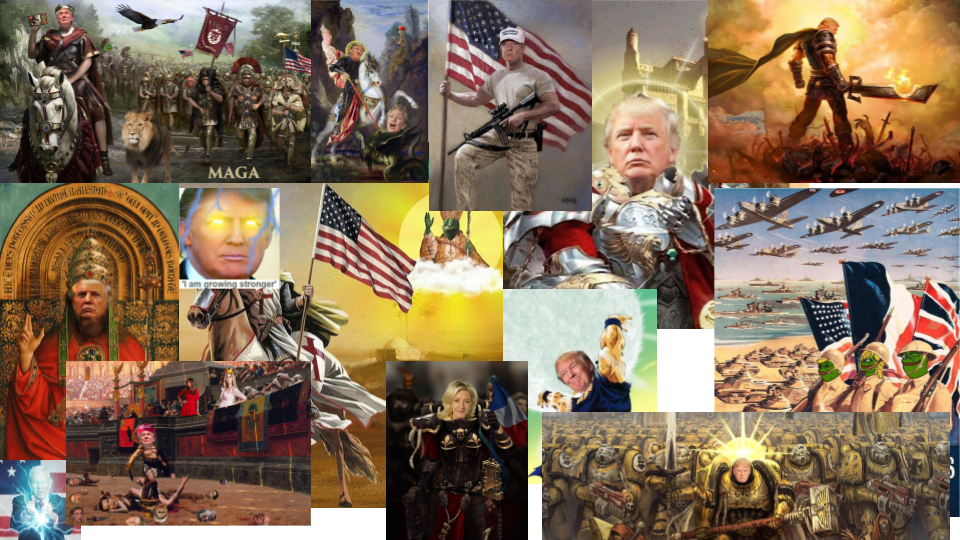 (fig. f)
(fig. f)
 (fig. g)
(fig. g)
The reactionary vision of futurity that the Europe Simulator image (fig. c) describes is depicted as what will happen if immigration policy is dictated by the liberal left—as exemplified by the German Christian Democrats iconography and the EU flag presented at the bottom of the packaging. Although the visual language of this image is defined by European geopolitics, as I have described, anti-immigrant rhetoric tends to evoke the same visual tropes. Thus, it is unsurprising when the God-Emperor himself, Donald Trump (fig. f), is presented as the protector of the sanctity of idealized white women against the primal hordes of ethnic Others. Depictions of Trump evoke a sun-swept Manichaean battlefield; the gilded Greco-Roman architecture in the distance evokes Mussolini’s promise of a New Roman Empire or the taste of Hitler’s “Great German Art Exhibition.” It is not difficult to make the leap to these classical fascist aesthetics from Trump’s own personal taste, which is similarly gilded and gaudy. The cult of masculinity in the images is self-evident (even in the images in which Marine Le-Pen is the protagonist, she is deliberately rendered androgynous). The aesthetics of war and technology have been updated for the youthful tastes of the alt-right—we see references to the role-playing game Warhammer, the Pepe the Frog meme, transhuman aesthetics via films such as The Matrix and Blade Runner, Dragonball Z, and videogames such as Counter Strike, all of which reflect newer notions of futuristic warfare. Again, the overtly racial narratives are hard to miss with certain memes reappropriating images of the first Crusade. “Deus Vult”—the rallying cry of the Order of the Holy Sepulchre—is copied-and-pasted into the comments incessantly (fig. g).13

(fig. h)
The futuristic gilded war-machine will presumably defend against the black rapist, the Syrian terrorist, the Chinese bureaucrat, and the Jewish cultural Marxist; however, just as investments into technological development during the cold war resulted in innovation outside the realm of defense, to the alt-right, the same mechanism that produces this gilded war-machine will also take us to the moon and beyond. The image of astronauts wearing red “Make America Great Again” Trump hats with Newt Gingrich (also wearing a Trump hat) in the distance is a direct reference to Gingrich’s 2012 campaign promise to colonize the moon (seriously) (fig. h).14 Here, we see the expansionist rhetoric of neo-fascism; just as science will liberate us from political correctness, it will also take us beyond our earthly confines. This notion of space colonialism is reflected in the music of one alt-right tastemaker, Galactic Lebensraum or CYBERNAZI, who fuses vaporwave and fascist aesthetics, providing a soundtrack for the future digital space reich.15 There is an emphasis on the infinite in these images as well, perhaps national expansionism with a corporate logic of unlimited growth. This reflects Trump’s own business history of course; in The Origins of Totalitarianism, Hannah Arendt describes how expansionism, as a political doctrine, borrows directly from the private sector.16 Thus, Trump’s experience as a business magnate (or at least, a symbol of a business magnate) allows the neo-fascist imagination to run wild with expansionist fantasies.
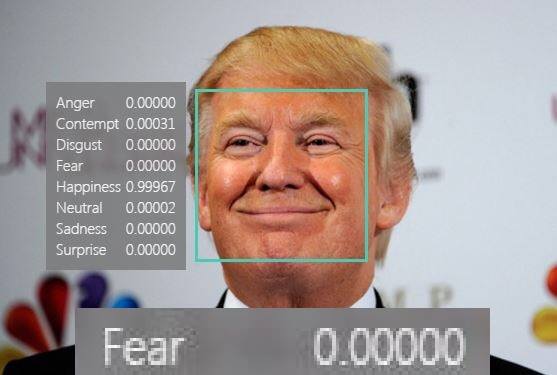 (fig. i)
(fig. i)
The extent of mechanization goes even further than the colonization of outer space. Ultimately, the aesthetics of the alt-right betray an expectation that the subject himself will transcend his human form thereby liberating himself from sexual agony and ambiguity. The images certainly have suicidal implications—one image (fig. i) in which the viewer looks upon Trump and can comprehend emotions only as numbers embodies a sort of violence of self that occurs as the subject attempts to transcend his humanly state. The reasons for this mechanized suicide are manifold—one could point to a normalization of high suicide rates of white males in middle America or a latent self-awareness of the consequences of a Trump presidency on the environment. These propagandic images embody multiple manifestations of representation-as-violence—sexual, epistemic, racial, physical, and self-inflicted. When Susan Sontag writes on Leni Riefenstahl, she describes fascism as unmistakably creating a cult of death; the aesthetics of neo-fascism reaffirm that claim.17
* * *
White Nationalism/Ethnonationalism/Nazism
There is, of course an explicitly fascistic portion of the alt-right (fig. j): the literal neo-Nazis, white supremacists, who will readily admit to identifying as such. Most of the images that I will survey come from the digital publication The Daily Stormer, which is a contemporaneous reboot of the Nazi publication The Stormer. Pictured below is the front page of one issue of The Stormer (fig. k) with the headline “die juden sind unser unglück”—the Jews are our misfortune. Additional content comes from the alt-right subreddit and the web publication The Right Stuff, which hosts two podcasts, one entitled Fash the Nation and another called The Daily Shoah (shoah refers to the Hebrew word for the Holocaust).
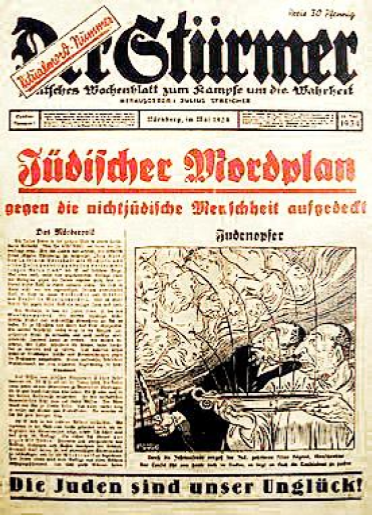
(fig. k)
Also considered within this category (although there is less of a visual culture to these organizations) are two institutions that have received significant media attention recently: the National Policy Institute, headed by Richard Spencer whose recent DC rally was documented by the Atlantic,18 and American Renaissance, a magazine founded and edited by Jared Taylor, a former Harvard University Japanese professor turned white nationalist.
 (fig. l)
(fig. l)
Most of the imagery circulated within these communities consists of direct allusions to Nazi propaganda (and is thus less creative and less interesting); however, since German fascism did include a sort of technocratic idealism, these newer images have been updated. One thread on the Daily Stormer is particularly illustrative of the aesthetic taste of these neo-Nazi communities (fig. l); 80s comics and sci-fi content offer normative gender roles, hyper-masculine futurist heroes, hypersexualized women, and a variety of visions of humans transcending their bodily limits via technological innovation.
 (fig. m)
(fig. m)

(fig. n)
In an animated gif (fig. m), the viewer is situated in the audience of the Nazi Red Skull from the second Captain America film. The Nazi soldiers (which the viewer initially assumes the perspective of and therefore identifies with) themselves resemble mechanical automatons—another instance of the viewer being articulated as a cyborg, further betraying a self-awareness that the members of the alt-right themselves might be harmed under the political conditions they seek to realize. This image is notable for its use of the “echo brackets”—triple parentheses which are used by many sections of the alt-right in order to designate someone of Jewish descent in larger paragraphs of text—that act as a digital gold star (fig. n). One member actually created a browser extension for the web-browser Google Chrome that inserts echo brackets around any individual of Jewish descent.19 The goal of echo brackets is to bring attention to the omnipotence of Jewish people within different media organizations, affirming the conspiracy theory of the cultural hegemony of Jewish people. In addition to being derived from the fascist hostility towards critical paradigms, echo brackets also evoke the Paleoconservative Pat Buchanan’s (also an idolized figure by the alt-right as the “previous cultural candidate for president”)20 conspiracy theory of “cultural Marxism” which can be understood to be dog-whistle anti-semitism directed towards criticism descended from the Frankfurt School (and other ideologies which might take the form of linguistic redefinition, political correctness, and identity politics).
 (fig. o)
(fig. o)
This image (fig. o) references popular circulated images of the electoral map which circulated after the Trump victory, highlighting how the Electoral College was split along race and gender lines. This image takes that logic of identity politics (it can be argued that the alt-right in general represents the strategies of progressive identity politics appropriated by white conservatives) and uses it to reinscribe the notion that multiculturalism and tolerance are holding the human race back from achieving its scientific potential. The idea that fulfilling its scientific potential is the responsibility of the human race is virtually axiomatic to the intellectual faction of the alt-right, but can also be identified as the opinion of more mainstream cultural figures including Francis Fukuyama, Elon Musk, and Peter Thiel; this image describes how quickly that logic can lead to white supremacy.
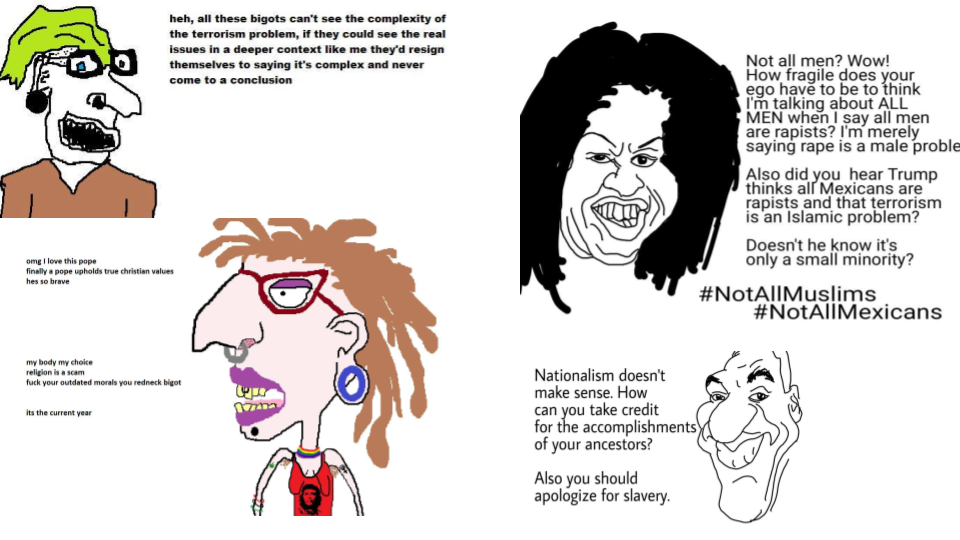 (fig. p)
(fig. p)
These memes (fig. p) are from a Facebook page called “Counter-Signal Memes for Fashy Goys,” with “goys” being short for goyem, the term for a man who is not of Jewish descent, and fashy being internet slang for both fascism and fashionable, perhaps unintentionally evoking Mussolini’s 1919 Naples speech in which he remarked on how “fascism brings back ‘style’ in people’s lives.”21 Here we see caricatures of Leftists; their “hashtag activism” is ridiculed and their identity politics are exposed as both hollow and convoluted. Given the connotation of identity politics with “cultural marxism” among the alt-right, it is unsurprising that aesthetic strategies used by fascists to caricature Jews (most notably exaggeratedly crooked teeth and large noses) are projected and conflated with stereotypes of the Left in general—the figures have dyed hair, piercings, buzzed haircuts, don’t wear bras, etc. This smug liberal trope is an exaggerated version of a stereotype invoked by conservatives quite often—it was certainly levied against Kerry, Gore, and Clinton. In a sense, the vast Jewish conspiracy and its somewhat more palatable cousin of “the cathedral” (as articulated by alt-right intellectual Curtis Yarvin) is not dissimilar from mainstream Trumpian rhetoric that brands the “Washington Establishment” as “the swamp.” Here we see a direct opposition to critical thought itself, to any gestures that create questions instead of answering them, that complicate instead of reduce. This can be understood as the alt-right follower turning away from what Freud might call the dark continent (both the racial and gendered uses of the term are prescient here); the fact that he can never know or comprehend the experience of the Other renders her an ontological void whose unknowability is too agonizing, thus he finds refuge in representation and, as this image describes, parody.
* * *
In a sense, an aesthetic analysis of the alt-right becomes more challenging when we attempt to approach its intellectual underpinnings, represented in the bottom two quadrants in fig. q. Although they obviously use visuals to supplement their blog posts, manifestos, e-books, etc., these intellectual factions do not use memes as their chief propagandic tool; rather, they write texts that aim to direct, discern, and laud the chaotic accumulation of the images that I have been referring to. However, this does not mean that the texts cannot be interrogated or thematized in a similar manner, but rather that more context and specificity is necessary, since there is a less rich visual language. Because both the accelerationist and the spiritual factions of the alt-right have their own sprawling associative canons, I would like to first contrast these two intellectual factions using a framework outlined by the Italian proto-Fascist philosopher Julius Evola. After that, I would like to focus on a mutual fascination for East and South Asia among these intellectual factions ultimately characterizing how they articulate different inegalitarian visions of futurity using Asia as both a historical inspiration and an empty container onto which this vision can be projected.
Julius Evola can be considered an ideological predecessor to the spiritual faction of the alt-right. Just as he was read and admired by Mussolini and printed in Nazi publications, alt-right blogs write about Evola admiringly.22 Additionally, Steve Bannon has presented at least a tertiary knowledge of Evola’s thought.23 An actual interrogation of Evola’s thought would be too significant a vagary from the general task of this paper; I am simply interested in invoking Evola’s distinction between two different kinds of racial inegalitarian philosophy in order to provide a helpful allegory for the difference between the spiritual and the accelerationist factions of the alt-right. In his text, The Social and Political Thought of Julius Evola, Cardiff historian Paul Furlong describes how to Evola, “race is an expression of [a supernatural] hierarchy. It is therefore seen as a vector of the divine impulse, a form of human commonality that combines both biological and spiritual characteristics … Evola seemed not to deny biological racism but to seek to relegate it to a minor explanatory role.”24 Furlong emphasizes that Evola does not base his racism in a belief in an empirical biological hierarchy in order to contrast Evola’s racism with that of Nazism, which relied immensely on scientific justifications. Ultimately, these two different justifications for racism between Evola and the Nazis serve as a potent allegory for the difference between the spiritual and the accelerationist factions of the alt-right intelligentsia; the former relies on religious, emotive, mythical tropes (both sourced from the past or created organically) while the latter relies on machines, logic, and science. I will begin by examining the aesthetics of the spiritual faction; in a sense, I regard the spiritual faction as having more rhetorical coherence with the Trump campaign since Trump is more of a neo-Luddite who grounds his racism in cultural arguments, as opposed to scientific ones.
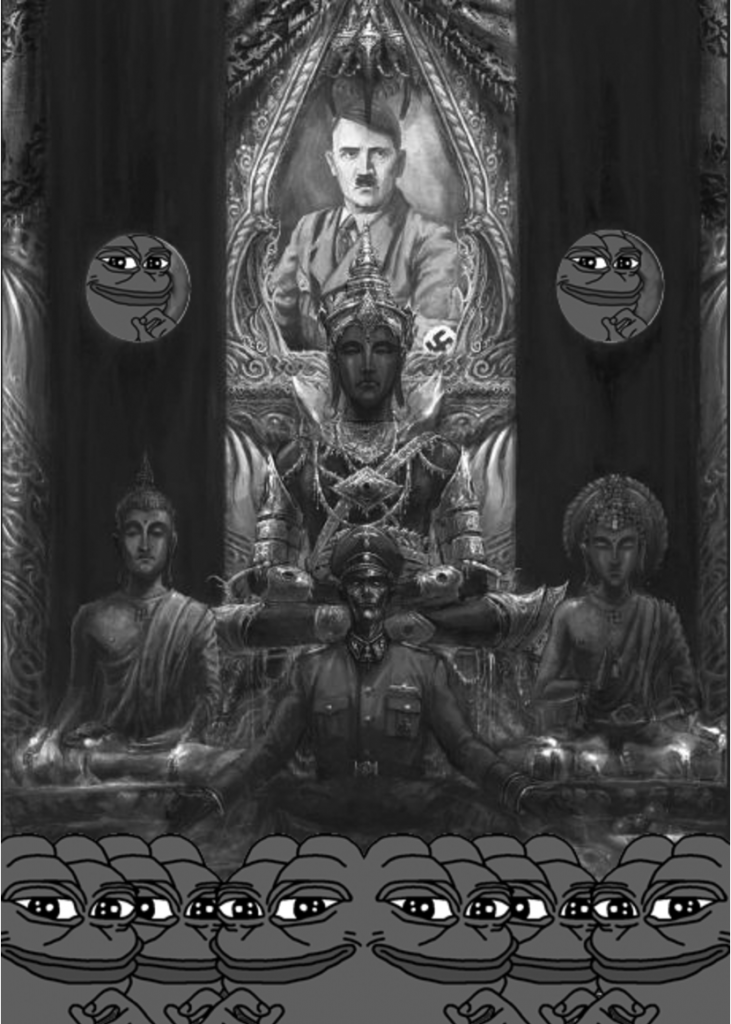 fig. r
fig. r
This image (fig. r) is from an article entitled Esoteric Kekism, or Kek as a Bodhisattva of Racial Enlightenment on the alt-right blog Atlantic Centurion. Atlantic Centurion is the blog of Lawrence Murray. In jargon-filled posts with eclectic titles including Proverbs of a Xenoskeptic Ethno-Nationalist, Murray blends political philosophy, a didactic narrative of the present, new media theory, and religious mythology into a bizarre brand of cultural criticism. In this article, Murray takes the alt-right’s favorite activity of rapidly accumulating political memes and drafts an understanding of that activity as a sort of religious ritual that can be concretized in images and text. Referring to the already notorious Pepe the Frog meme, Murray asserts that the alt-right has a central deity god, Kek, whose name is derived from a bastardized type-input error of the term “lol”; the letters l and o are next to k and i on the keyboard; the mistyped kik becomes kek through an assimilation of the phonetic form of the typo. Kek is a chaos god whose magical abilities, referred to as meme magic, can be invoked through distributing memes. Through Kek, whatever desire is expressed in the meme—for Trump to be elected, for the UK to vote leave, for WikiLeaks to release more emails, etc.—becomes reality. The alt-right meme warrior praises his/her god with the ubiquitous phrase “Praise Kek”. A number of theorists have written about Kek, with the most effective piece being Tara Isabella Burton’s essay Apocalypse Whatever, in which Burton remarks “it doesn’t matter whether Kek is ‘really’ a chaos god. He might as well be. Likewise, meme magic, to the extent that that it serves as a record of cultural engagement, is real too.”25 Thus, debating whether or not esoteric kekism should be regarded as a legitimate religion is beside the point; in my aesthetic analysis, I am more interested in why Murray invokes Buddhism as the model for his creative endeavor.
In fig. r, we see the repeated motif of Pepe the Frog operating as monks in a Nazi/Buddhist temple. An undead or cyborg-esque SS general is seen in the seated lotus position, in front of three different Buddhist figures, who are in turn all situated in front of a giant shrine to Hitler. The image is notably devoid of color in order to aid the assimilation of the Eastern imagery with its white supremacist implications; color constitutes difference, the desaturation operates as a visual reflection of Murray’s opening assertion that the Buddha was, in fact, white. This kind of historical re-reading is not a new invention; Murray’s whitewashing of Buddhism has historical parallels in the Nazi occultist Maximine Portaz (pseudonymously known as Savitri Devi) who sought to synthesize Nazism with Hinduism (Murray also begins his essay with a reference to Portaz) and in Evola’s fascism which drew heavily from Hindu scripture. Ultimately, the whitewashing and appropriation of Buddhist imagery allows the alt-right to reconcile cultural accomplishments by racial Others with its own ethno-nationalist conviction. It also gives the alt-right a transgressive, exhilarating quality—something that, as Milo Yiannopoulos wrote in his Establishment Conservative’s Guide to the Alt-Right, the alt-right prides itself on.26
 fig. s
fig. s
Of course, on a more rudimentary level, East Asian aesthetics appeal to the tastes of the demography of the alt-right—internet culture and its large constituency of young white male millennials have been fascinated with anime and cyberpunk long before the alt-right existed in its contemporaneous form. In the previous image also pulled from Atlantic Centurion, we see an image of a younger Trump flanked by light-skinned anime girls wearing Make America Great Again caps. Here (fig. s), just as rereading the Buddha as an Aryan religious icon became a rhetorical strategy to contextualise reblogging and reposting memes as a religious activity, a sign that lay audiences might associate with Asian (in this case, Japanese) culture actually functions as an endorsement of white supremacy. One attribute of the girls in this image that might not strike the viewer as unorthodox is the figures’ large eyes, which are obviously cartoonishly exaggerated and frankly made to look more European. This is not how anime eyes always looked, as explained in media theorist Wendy Hui Kyong Chun’s text Control and Freedom. Chun cites Mary Grigsby, who recounts how “before the Japanese came into contact with Westerners they drew themselves with Asian features. After contact with the West, particularly after World War II and the subsequent reconstruction of Japan under the domination of the United States, they began to depict characteristics that are supposed to be Japanese with Western idealized physical characteristics: round eyes, blonde, red or brown hair, long legs and thin bodies.”27 Thus, we see something that should be contradictory—the representation of a non-European art form should be regarded as degenerate by the alt-right, but it actually becomes a Eurocentric statement; the Westernization of the anime girl is appealing to the alt-right viewer because it represents the perceived successes of Imperial domination, to the extent that a foreign adversary ends up taking care of the whitewashing itself.
* * *
Transhumanism/Right-Accelerationism/Scientism/Libertarianism
The spiritual faction of the alt-right engages in practices of religious reappropriation and the construction of a new kind of spirituality based in the language and activity of the digital. On the other hand, the technological-determinist faction of the alt-right intelligentsia embodied in what can be understood as an ideological predecessor to the right, the Neoreactionaries instead place their faith in accelerated capitalism, technological innovation, and transhumanism. Pseudonymous cultural critic Josephine Armistead has outlined key tenets of Neoreactionism in her essay The Silicon Ideology; many of these tenets cohere with images I’ve already shown, including a faith in transhumanism, a preference for authoritarianism under a tech CEO or a super-intelligent AI, and essentialist inegalitarian attitudes towards race and gender under the more palatable term “human biodiversity”.28 Today, Neoreactionism has a contentious relationship with the rapidly radicalizing alt-right; however, while its well-known voices have distanced themselves, the ideas that Neoreactionism espouses are pervasive across the alt-right and in popular political discourse in certain parts of the country, most notably in Silicon Valley.
A key intellectual forefather of Neoreactionism is Curtis Yarvin who between 2007 and 2014, under the pseudonym Mencius Moldbug, laid the groundwork for Neoreactionism on his blog, Unqualified Reservations. Yarvin takes aim at democracy and egalitarianism, but his most enduring contribution has been defining and repeatedly levying verbal indictments at what he refers to as the Cathedral29—the combination of the University system, mainstream media outlets, and state legislatures which Yarvin regards as oppressive, stultifying, and indoctrinating.30
A more recognizable name in Neoreactionism is Nick Land, a media theorist, philosopher, and aesthetician previously affiliated with the University of Warwick. Nick Land is typically recognized for his advocacy for accelerationism—the notion that we should accelerate the development of capitalism. Accelerationism has advocates across the political spectrum; for the Left, accelerationism is appealing so that we can reveal the flaws of capitalism and bring about its end; for the Right, accelerationism is appealing to the extent that we can further reap the financial and lifestyle benefits of capitalism’s innovative capacities. Landian accelerationism is defined by an awareness that capitalism atomizes bodies, subjugates certain populations, and ultimately dissolves the domain of the social. For Nick Land, however, this is not a negative; he regards the creative capacity of capitalism entirely redeeming of its consequences on the body. Land believes that we should accelerate capitalism as we know it in order to unleash “thanatropic machinism” (here we again encounter the cult of death) which he defines as a collective productive engine that will emerge once man liberates himself from correlationalist (or anthropocentric) egalitarian models of society and subjectivity. To Land, we will, ultimately submit to the authority of Number which is not simply a quantitative unit or arithmetic concept but rather a dynamic scalable architecture that is alluded to by object-oriented programming languages, artificial intelligence, electronic music, and video games.
While the spiritual faction of the alt-right reappropriates East Asian texts (either religio-historical in the Buddha-as-white-nationalist-Avatar or pop cultural as with the Anime Trump meme) for the accelerationist Neoreactionaries, East Asia has a radically different function. Instead of serving as a site for historical excavation and reconsideration, Neoreactionism regards East Asia as a site of futurity—either an actual model to be emulated, or a sort of field onto which hypercapitalist totalitarian fantasies can be imposed.
 (fig. u)
(fig. u)
This image (fig. u) is not a juxtaposition of picture and text like the previous highlighted images—it’s a photograph of the Singaporean authoritarian leader Lee Kuan Yew. This image comes from an obituary post on Nick Land’s blog Outside In after Lee Kuan Yew died in 2015.31 The post is titled “Greatness”, and it praises Lee Kuan Yew for being a Neoreactionary before anybody knew what that term actually was. Land chooses to highlight how Kuan Yew refashioned the Singaporean state based on a model of widespread privatization. Land’s assertion that Kuan Yew is the most influential leader of the 20th century echoes a sentiment expressed by Slavoj Žižek in his text First as Tragedy, Then as Farce. Žižek quotes philosopher Peter Sloterdijk who also makes the assertion that Kuan Yew will be remembered as the most influential figure of the 20th century. Žižek continues to elaborate on Kuan Yew’s influence, attributing to him a living, compelling example that capitalism and liberal democracy do not necessarily require each other but might actually be antagonistic toward each other, and that capitalism might function better under authoritarianism.32
 (fig. v)
(fig. v)
I choose to link Žižek’s pairing of Capitalism to “Asian Values” with Land’s admiration for Lee Kuan Yew because they both embody a kind of techno-Orientalist idealization of the Far East as a testing ground or prototypical society where we can observe what transpires when the embodiment of capital itself becomes the organizing mechanism of state power. Furthermore, if we take the transhuman aesthetics that underscore much of Land’s thought (particularly through his analysis of William Gibson and EDM33), the Neoreactionist vision of society includes a relegation of the social and the physical body to capital. Thus, I return to an image (fig. v) that was not pulled directly from a Neoreactionary blog (it was found in a recent Vice article about an alt-right EDM movement called fashwave34), but that I believe represents the endurance of Landian accelerationist techno-Orientalist fantasies of authoritarian capitalism. Here, we see a futuristic skyline in which every single building seems to be part of the Trump corporate ecosystem. It’s not that far in the future—perhaps drawing inspiration from the Japanese economic miracle; the image projects a vision of growth that is exponential as opposed to incremental. The skyline operates as a Western caricature of East Asian futurity—it resembles either Shanghai or Tokyo—but, the repeated pyramid is familiar sign of a hierarchical, totalitarian order. Furthermore, the fact that the new galactic emperor appears to be Trump’s son, Barron, implies that this future state does not hold democratic elections but, instead, relies on a dynastic monarchic transition of power.
Few other buildings are labeled at all; however, it is possible to make out two other building signs. One is a cocktail bar, presumably an expansion of Trump’s Las Vegas and Atlantic City casino properties. The other is an arcade which, at a glance, is a nod to the gamer demography of the alt-right. However, just as images like this seem to betray a fundamental understanding of the ecological crisis (to the extent that this image is also immensely hazy) it also betrays a totalizing melancholy that the alt-right constituent either tacitly enjoys or isn’t willing to overtly disclose. After all, if this utopian vision is so grand, why is the escapism of a giant institutional arcade necessary? Surely, in this fantasy the enjoyment found in video games could be found in everyday life. The fact that in a projected techno-utopian ethnostate there is an increased need for escape reveals that this vision is not one of emancipation but one of a glitzy self-indulgent annihilation. As the urban development continues to accelerate, the imperative to evaporate into an invented world becomes stronger. Thus, we see the tragedy of the alt-right—it has no legible end; even when it tries to articulate a vision for the future, it relies on recycled 80s tropes and ultimately looks more or less like a barbaric version of status quo: corporate rule coupled with an alienated, atomized public.
In attempting to theorize German fascism, Walter Benjamin wrote that at the heart of fascism is a revolutionary impulse; however, this impulse, when devoid of class consciousness, becomes animalistic and libidinal, an urge that lashes out without fundamentally targeting or changing the economic status quo.35 Within the new fascism we are currently witnessing, the revolt is not against capitalism itself but against capitalism’s brand—namely globalism, multiculturalism, and cosmopolitanism. Unable to liberate themselves from the fundamental religion of capitalism, neo-fascists actually double down on its perceived graces, namely that of technological innovation. The ultimate repudiation of what Zizek calls ethical capitalism36 (think of a Hillary Clinton campaign ad—capitalism with a multicultural face or environmentally conscious, recyclable, brown exterior) takes the form of a new penchant for imperialism, colonialism, and environmental destruction. Ultimately, this newfound (currently largely performative) indulgence coheres quite efficiently with the classic fascist fetishization of war and finds itself temporally prescient in responding to the current migrant crisis that has brought Europe to its knees.
We also have something quite powerful in terms of critical paradigms insofar as these images betray their own delusion, insecurity, or ideological context. To decode them is the first step in fighting back, presumably; it is a far more effective option than simply generalizing or digging one’s head further into the sand. Furthermore, thematizing neo-fascism empowers the individual to identify what Deleuze and Guattari might call microfascisms37—fascistic tendencies on a small scale which are pernicious throughout everyday life or, in the case of Adorno, personality types that are predisposed towards authoritarianism.38 Boris Buden, in his recent op-ed for e-flux titled “Contemporary Fascism and the Limits of Historical Analogy”, concludes by asserting that “drawing analogies between contemporary fascism and historical fascism is far from our worst analytic tool for confronting the dangers of today’s crisis-ridden global capitalism. So we might as well make productive use of it, but only insofar as we have another tool at hand—a knife.”39 Buden is not wrong that criticism, analogy, and metaphor are insufficient tools for combating neo-fascism; however the aesthetic nature of contemporary fascism is, in a sense, an undeniable affirmation of the power of propagandic images in today’s visual culture. The right has outpaced the left in terms of how deftly they have used these images and have thus built a coalition of large swaths of voters in the US and Europe. Thus, the knife is probably not the best tool either; the most optimal tool for combatting neo-fascism is the image, the algorithmic sorting mechanism, and the narrative, all of which can be employed as a means of redirecting society from performances towards politics.
Correction: In the initial version of this essay, M. Ambedkar misrepresents the origins of the term “kek”. It is not, as he writes, the result of a typo but in fact has origins in the World of Warcraft community. In the game, different races have language filters such that when an enemy of a different race speaks to the player, the letters are changed; when an Orc says “lol” to an Alliance member, it shows up as “kek”.
Credit to Mal Scott (and many other commenters) for pointing out this error.
